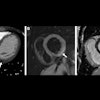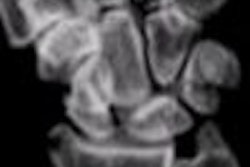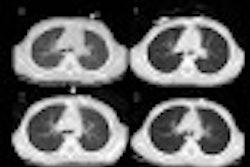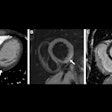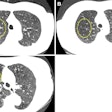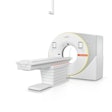BOSTON - Here's the question: If virtual colonoscopy is already expensive, is it nobler to keep it as cheap as possible? Or to take arms against missed cancers by adding contrast, and by doing so increase the cost and complexity of the procedure?
At the International Symposium on Virtual Colonoscopy on Monday, two researchers offered opposing views of intravenous contrast enhancement. Dr. Martina Morrin from Beth Deaconess Medical Center in Boston found that contrast improved the conspicuity of polyps, as well as reader confidence in the results.
Dr. Erik Paulson, associate professor and chief of abdominal imaging at Duke University Medical Center in Durham, NC, argued that contrast tips the balance against VC by adding needless expense, risk, time, and hassle.
"The potential clinical applications of contrast-enhanced CT colonography ... include improvement in detection of colorectal cancer and polyps, and possibly in staging in colorectal cancer and in helping to identify dysplasia," Morrin said. Contrast can also help distinguish the bowel wall and mural wall abnormalities from luminal contents, she said, especially when colonic distension or bowel preparation is suboptimal.
Morrin said her group examined 200 patients who underwent virtual colonoscopy in the prone position. One hundred fifteen of the patients received 150 cc of Optiray contrast (Mallinckrodt, St. Louis), injected at 3 cc/second with a scan delay of 45 seconds. Rated on a five-point scale, the readers found that enhancement increased diagnostic confidence significantly (Radiology, December 2000, Vol. 217:3, pp. 765-771).
"In the same study, we looked at 81 patients who had complete colonoscopic and surgical correlation, and compared the diagnostic accuracy in 48 patients who received contrast and 33 patients who did not," Morrin said. The addition of intravenous contrast significantly improved sensitivity for medium-sized polyps (from 58% to 75%, p<0.05), and there was very little difference in sensitivity for the large polyps, she said. However, some large polyps of 10-19 mm, which were submerged in retained fluid or stool, were detected only as a result of contrast enhancement.
So far the group has performed about 700 virtual colonoscopies at Beth Deaconess, she said. The standard procedure is to perform a supine noncontrast VC first, and in any case in which fluid is present in 50% or more of the lumen, the patient undergoes a second scan with the addition of contrast. About 15% of the patients have received contrast.
The group is currently working on a study to assess the technique for the staging of colorectal cancer. Among 34 patients so far, 16 had tumor-staged colorectal cancer. Twenty of the patients had colorectal masses, 7 had obstructing lesions, and 7 had undergone prior colorectal dissection, Morrin said.
"We correctly staged 13 of the 16 colorectal cancers; all 13 patients who were correctly staged had received intravenous contrast, and all 3 patients who were incorrectly staged did not receive intravenous contrast," she said. "Of the three patients who did not receive contrast, 2 were understaged, and 1 was overstaged. Intravenous contrast CT colonography resulted in the detection of 93% of synchronous disease, and 2 patients with cancer had metastases identified at the time of the examination."
The main drawback of contrast is the added cost, as well as a small risk of a reaction to iodinated contrast. "And it may not be logistically possible to check every supine scan" to assess the need for contrast, Morrin said. But the degree of enhancement is proportional to the aggressiveness of the tumor, she said, and contrast enhancement is often the only way to find rare malignancies such as mucinous tumors.
In contrast, or rather a lack thereof, Paulson said that while contrast enhancement has yet to be studied extensively in VC, Morrin's group has certainly done the best work in the field. Intravenous contrast probably does have a positive effect when used with patients who have known colon cancer, or suspected recurrent colon cancer, he added.
"My argument against (enhancement) will rest on the marginal benefit in polyp detection, the cost, the issue of contrast reaction, the hassle of giving contrast, and workstation time," he said.
Citing Morris and colleagues' original study of 200 patients, there was a modest increase in reader confidence and a modest increase in bowel wall conspicuity in the prone group, he said, but the advantage of contrast in the supine group was less clear. And while there was some benefit in detecting medium-sized polyps, the advantage did not extend significantly to small and large polyps.
"As it is, without IV contrast the cost/benefit equation for CT colonography is sort of split -- you can find all the books that argue that CT colonography is not a cost-effective procedure compared to barium enema and optical colonoscopy," Paulson said. "If you add IV contrast...clearly the balance will be tipped against CT colonography."
As for contrast reactions, they're not cause for great alarm, but in his practice minor reactions occur weekly and serious reactions occur perhaps once a year, Paulson said. And the risk of kidney insufficiency mandates creatinine testing in some patients before contrast administration, further upping the price.
Then there's the issue of workstations and window levels. The standard polyp search occurs in the workstation's lung windows, he said, but adding contrast necessitates additional time in the soft-tissue windows, lengthening overall interpretation time. In some cases interpretation can even be confounded by the addition of contrast, he said, though he agreed with Morrin that more research is needed.
"Probably the biggest thing that makes me cringe when I think about adding IV contrast is the hassle," Paulson said. "By adding contrast I lengthen the procedure. I have to get my nurses in the room. My nurses like CT colonography. Why? Because they're not involved. My technologists like it because it's pretty short; if I add contrast all of a sudden it turns into a bigger deal. Contrast adds invasiveness and it adds pain. Further, if I were going to use contrast I think I'd split the bolus and use it for both (prone and supine) acquisitions, not just one acquisition."
By Eric BarnesAuntMinnie.com staff writer
April 10, 2002
Related Reading
Ultra-low-dose CT colonography compares with colonoscopy, March 3, 2002
All colorectal cancer screening methods effective; best still uncertain, February 28, 2002
Multislice scanning cuts radiation dose in CT colonography, January 10, 2002
CT colonography performs very well in five-year study, November 26, 2001
Copyright © 2002 AuntMinnie.com
